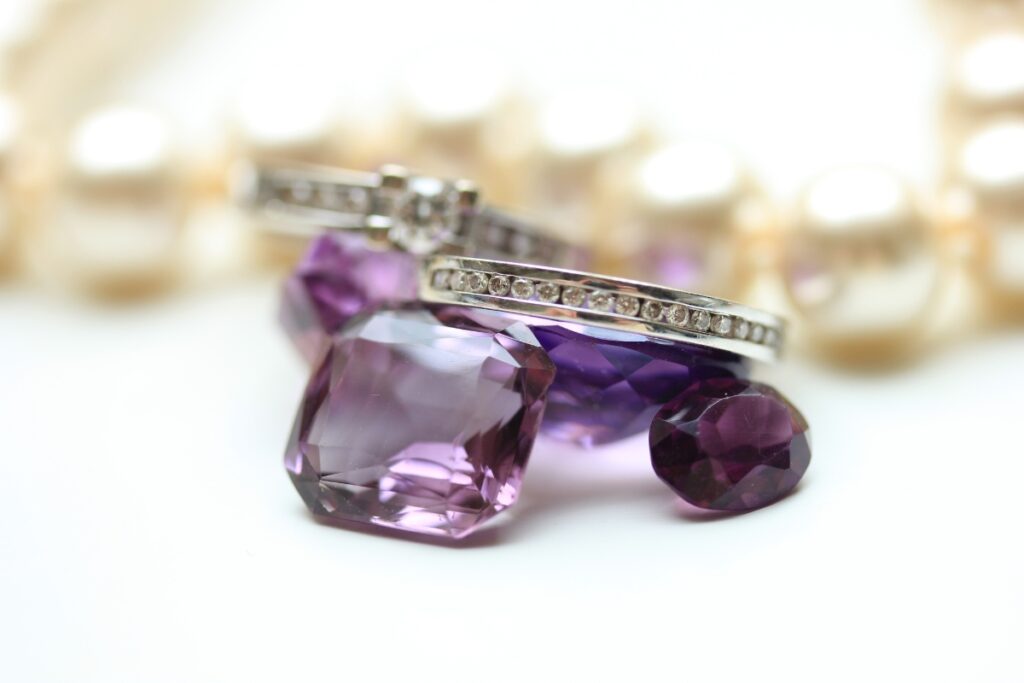Gemstones have captivated humanity for centuries, not just for their beauty but also for their deep symbolism and meaning. From ancient civilizations to modern-day fashion, gemstones have been cherished as symbols of power, love, protection, and more. Whether you’re choosing a gemstone for its aesthetic appeal or its significance, understanding the stories behind these precious stones can add an extra layer of meaning to your jewelry. Let’s dive into the symbolism behind some of the most popular gemstones.
1. Diamond: The Stone of Eternal Love
Symbolism: Diamonds are synonymous with love, strength, and eternity. Their unmatched hardness and brilliance make them a symbol of unbreakable bonds and everlasting commitment.
- History: Ancient Greeks believed diamonds were tears of the gods, while Romans thought they were splinters of fallen stars.
- Modern Meaning: Today, diamonds are the ultimate symbol of love and are often used in engagement rings.
- Emotional Connection: Diamonds are said to enhance clarity, courage, and inner strength.
2. Sapphire: The Stone of Wisdom and Royalty
Symbolism: Sapphires are associated with wisdom, loyalty, and nobility. Their deep blue hue has long been linked to the heavens and divine favor.
- History: Ancient Persians believed the sky was painted blue by the reflection of sapphires. Medieval clergy wore sapphires to symbolize heaven.
- Modern Meaning: Sapphires are popular in engagement rings and are often associated with royalty (think Princess Diana’s iconic sapphire ring).
- Emotional Connection: Sapphires are believed to bring peace, focus, and spiritual insight.
3. Emerald: The Stone of Growth and Renewal
Symbolism: Emeralds represent growth, renewal, and abundance. Their lush green color is reminiscent of nature and springtime.
- History: Ancient Egyptians associated emeralds with fertility and rebirth. Cleopatra was famously fond of emeralds.
- Modern Meaning: Emeralds are often given as gifts to celebrate new beginnings, such as anniversaries or the birth of a child.
- Emotional Connection: Emeralds are said to promote emotional balance, compassion, and harmony.
4. Ruby: The Stone of Passion and Vitality
Symbolism: Rubies are the ultimate symbol of passion, energy, and courage. Their fiery red hue has long been associated with life force and power.
- History: In ancient India, rubies were known as the “king of gemstones” and were believed to protect warriors in battle.
- Modern Meaning: Rubies are often given as gifts to celebrate milestones or to express deep love and devotion.
- Emotional Connection: Rubies are said to ignite passion, boost confidence, and inspire courage.
5. Pearl: The Stone of Purity and Wisdom
Symbolism: Pearls are unique among gemstones as they are formed within living creatures. They symbolize purity, innocence, and wisdom.
- History: In ancient Rome, pearls were considered the ultimate symbol of wealth and status. In many cultures, they are associated with the moon and feminine energy.
- Modern Meaning: Pearls are often worn by brides and are a timeless choice for classic elegance.
- Emotional Connection: Pearls are believed to promote calmness, clarity, and emotional balance.
6. Amethyst: The Stone of Peace and Protection
Symbolism: Amethyst is known for its calming energy and protective qualities. Its purple hue has long been associated with spirituality and tranquility.
- History: Ancient Greeks believed amethyst could prevent intoxication and promote a clear mind. It was also used by royalty as a symbol of power.
- Modern Meaning: Amethyst is often used in meditation practices and is a popular choice for spiritual jewelry.
- Emotional Connection: Amethyst is said to reduce stress, enhance intuition, and promote emotional healing.
7. Opal: The Stone of Creativity and Inspiration
Symbolism: Opals are known for their mesmerizing play-of-color, which symbolizes creativity, inspiration, and imagination.
- History: Ancient Romans believed opals were the most precious gemstones because they contained the colors of all other stones.
- Modern Meaning: Opals are often associated with artistic expression and are a popular choice for unique, one-of-a-kind jewelry.
- Emotional Connection: Opals are said to enhance creativity, spontaneity, and self-expression.
8. Topaz: The Stone of Strength and Clarity
Symbolism: Topaz is associated with strength, clarity, and focus. Its warm hues range from golden yellow to deep blue.
- History: Ancient Egyptians believed topaz was colored by the sun god Ra, while Romans associated it with Jupiter, the king of the gods.
- Modern Meaning: Blue topaz is a popular choice for December birthdays and is often used in statement jewelry.
- Emotional Connection: Topaz is said to promote mental clarity, confidence, and emotional balance.
Conclusion
Gemstones are more than just beautiful adornments—they carry centuries of history, meaning, and symbolism. Whether you’re drawn to the fiery passion of a ruby, the calming energy of an amethyst, or the timeless elegance of a diamond, each gemstone tells a story. By understanding the symbolism behind these precious stones, you can choose jewelry that not only looks stunning but also resonates with your personal journey.


